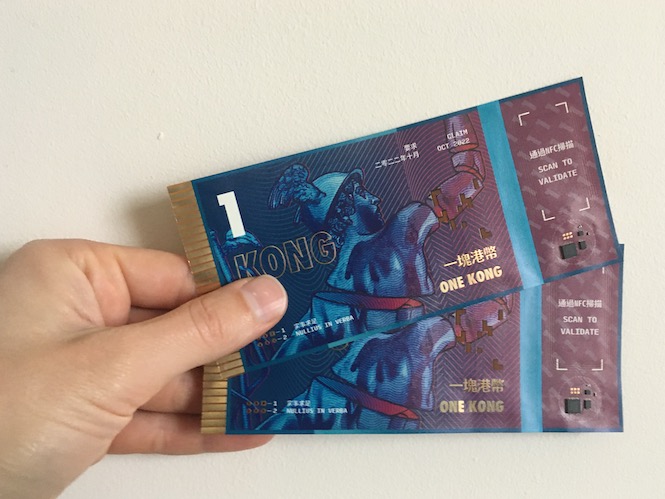🦍
This really blows my mind. Kong is physical cryptocurrency:

Kong is an ethereum token in the same way Dai is. But Kong (the project) also mint the physical notes in the picture above. Every note is backed by an ethereum smart contract that locks up the corresponding number of Kong tokens. So if you have a five Kong note, there’s a corresponding smart contract that locks five Kong tokens.
To get hold of the tokens you have to wait for the note to expire (every note has an expiry date printed on it) and then prove you’re the holder of the note.
So far, so mind-blowing, but it gets really nutty when it comes to proving you’re the bearer. Every note has a secure chip on it, which contains a keypair generated when the note was minted. You can query the note (over RFID or physical connection) for its public key. You can also ask it to sign some data, to prove it has the private key. But you can’t get the private key out.
The theory is you can pay for goods and services with the notes and as long as they haven’t expired you know they’re valid promises to pay the bearer the number of tokens that are printed on them. Just like cash is (or was) a promise to pay the bearer a certain amount of gold. You don’t need to ever colect the gold for the note to be valuable.
Whoever’s holding the note when it expires can use it to unlock the Kong tokens in the corresponding smart contract.
🥜
People who accept Kong don’t need to test the notes, unless they suspect they’re damaged. As long as they haven’t expired they’re valid.
The notes can change hands any number of times before they expire. Once the note expires it might still have some value (if it hasn’t been used to unlock the corresponding Kong tokens), but determining that would require someone to be online. Much better to consider them worthless once they expire.
Whoever holds the Kong note when it expires now has Kong tokens to spend, rather than the promise of Kong tokens. This is a bit like a bank note expiring and the holder being left with the gold that backed it. It’s very nice but what can you do with it?
It gets even more interesting when you find out Kong doesn’t yet have an agreed value. This makes the case of forgery interesting. If Kong become very valuable then there becomes an economic incentive to forge the notes. As long as the value of a Kong is less than the cost of forging a note then there’s no point in forging them.
There’s another way to get hold of Kong tokens: a lockdrop. You lock up some eth and at the end of the lock period you get your eth back plus a share of the Kong that was minted. If you’ve got MetaMask then participating in the lockdrop is as easy as visiting the webpage and selecting how much eth and how long you want to lock it for.
🤯
Got all that?
In the next post we’ll look at another awesome application built on ethereum: Enzypt. Coming soon…